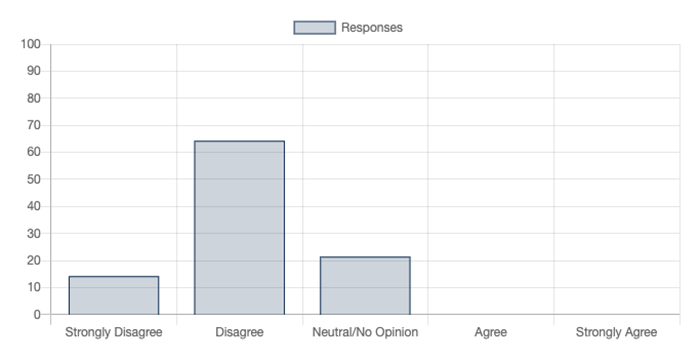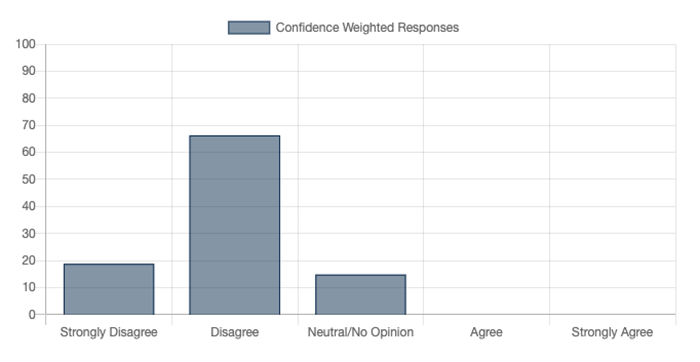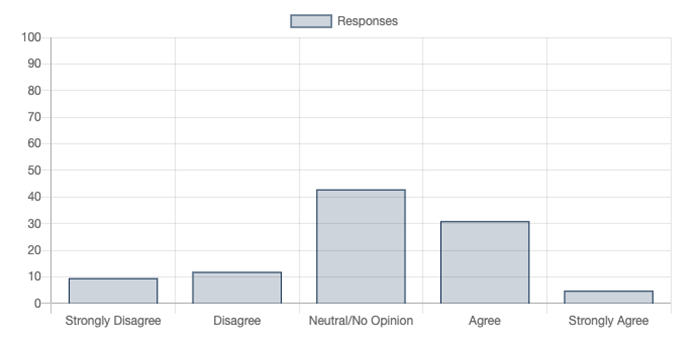After someone is arrested, they might wait weeks or months for their case to be resolved, and they might have to wait in jail. On any given day in the United States, about half a million people are detained pretrial — that is, incarcerated before they are convicted or sentenced. In theory, pretrial detention ensures that defendants do not commit any additional offenses pre-disposition, including failing to appear for their legal proceedings. But does our use of pretrial detention make communities safer? If not, what should we do? Which policy reforms would meaningfully reduce the number of people detained pretrial?
We recently polled the Criminal Justice Expert Panel (CJEP) on this topic. (See our earlier post for more information on the CJEP.) We provided three statements about pretrial detention, and asked our panelists to rate their level of agreement on a five-point scale from strongly disagree to strongly agree. We also asked our panelists to rate their level of confidence in their response, from 0 (not at all confident) to 10 (very confident). This allows us to aggregate their responses as raw averages across all panelists, and as weighted averages that give more weight to the responses of panelists who were more confident – perhaps because this topic is firmly in their area of expertise and they know the research literature well.
The results are below. You can also explore individual panelists’ responses on the CJEP website. And stay tuned for future surveys! On the website, you can sign up for the CJEP newsletter to be the first to hear about new survey results. You can also follow the CJEP on Twitter.
Criminal Justice Expert Panel Survey Results: Pretrial Detention
Statement 1: Reducing the number of people detained pretrial will lead to a net increase in crime in the medium- to long-term.


Selected panelist comments (edited lightly to correct typos):
“The existing evidence suggests that the rates of pretrial detention may not be justified by the average reduction in the risk of crime. However, it is possible that pretrial detention leads to general deterrence effects that should be taken into account.” – Anna Bindler (University of Cologne)
“Detaining people pretrial, especially for non-violent offenses, has many costs and may lead to greater crime in the long run due to the costs of being detained (e.g., loss of employment, loss of housing, family separation, etc.).” – Robynn Cox (University of Southern California)
“The crime effect of reducing pre-trial detention will depend on which defendants are affected, and even then it is hard to know. While some individuals released pre-trial commit offenses while awaiting their trial, the experience of pre-trial detention may itself lead to future criminal behavior (in addition to its other damaging effects). So it is unclear what the net impact on crime would be.” – Felipe Goncalves (UCLA)
“Although the evidence from good causal studies is mixed, with some finding a zero net effect of pretrial detention in the medium to long term, and some finding that detention actually increases crime once we get beyond the short-run incapacitation stage, studies are consistent in showing that detention doesn’t decrease crime.” – Paul Heaton (University of Pennsylvania)
“Focus on medium to long-term is key here. Pretrial detention will have an incapacitation effect in the short-term, but detrimental consequences on employment and earnings in the future. Individuals detained pretrial are more likely to plead guilty and face the collateral consequences of a conviction, increasing the risks for criminal activity long-term.” – David Kirk (University of Oxford)
Statement 2: Ending the use of cash bail will meaningfully reduce the number of people detained pretrial.


Selected panelist comments (edited lightly to correct typos):
“Elimination of cash bail is a much-needed reform since the system amounts to punishment for poverty, and informational nudges can be used effectively to ensure appearance at future court proceedings. Carve outs for certain offenses are still overly broad, in my view, and should be restricted. An even more impactful reform would be to eliminate bookings altogether for a large class of offenses.” – Robert Apel (Rutgers University)
“Ouss and Stevenson (2021) report that ending low cash bail requests had no effect on pretrial detention in Philadelphia, because those affected by the policy were generally able to make bail prior to the policy’s implementation. Judges may also offset a broader prohibition on cash bail by increasing their use of detention orders, with unclear effects on the number of people detained pretrial.” – Anna Harvey (New York University)
“This would depend on what mechanism, if any, is put in place as a replacement for cash bail. However, looking at states and jurisdictions that have reduced or ended the use of cash bail (e.g., New Jersey, Philadelphia), these policies do seem to reduce the number of people detained pretrial (although I have some uncertainty around the magnitude that can be causally attributed to the end of cash bail).” – Rosanna Smart (RAND Corporation)
“Among people with identical cash bail amounts–so ostensibly similar perceived recidivism risk–those from poorer areas are more likely to be detained. It’s not crystal clear to me that replacing cash bail with another policy will lead to lower rates of detention or will change the characteristics of those who are detained based on the new heuristic a judge would adopt.” – Greg Midgette (University of Maryland)
“I think it all depends on what, if anything, replaces cash bail. Would there be other requirements that may be hard for individuals to meet?” – Kevin Schnepel (Simon Fraser University)
Statement 3: Using risk assessment to inform detention decisions will meaningfully reduce the number of people detained pretrial.


Selected panelist comments (edited lightly to correct typos):
“1) Research shows quite clearly that risk assessment alone doesn’t change anything if magistrates still retain ultimate discretion. 2)The risk assessment tool only rank orders risk. Policy makers must still decide where to put the cutoffs for detention.” – Shawn Bushway (RAND Corporation)
“My concern is related to how these risk assessments may incorporate pre existing biases and further exacerbate racial disparities in the criminal justice system. In my opinion, risk assessments should be part of a multifaceted approach to reduce the number of people detained pretrial.” – Jamein Cunningham (Cornell University)
“This likely depends on (i) the goal of the risk assessment (to reduce the number detained? to reduce disparities in who is detained?) and (ii) whether judges or bail officers use significant discretion in deviating from the guidelines provided in the risk assessment tool. ” – Randi Hjalmarsson (University of Gothenburg)
“Given the risk aversion of judges, any exogenous assessment of risk would reduce their personal and reputational risk of releasing individuals pre-trial.” – Michael Makowsky (Clemson University)
“There is simulation work that suggests risk assessment tools could theoretically reduce the number of people detained pretrial, but that doesn’t mean that as actually implemented they will do so. See Stevenson 2018, for example, on Kentucky’s use of these tools.” – Ariel White (MIT)
Photo credit: wildpixel via iStock